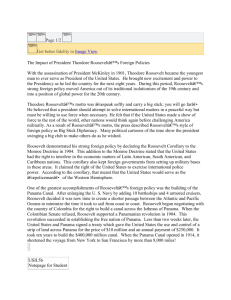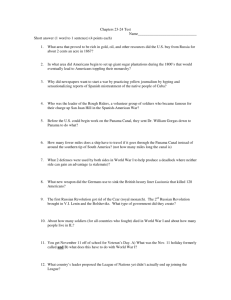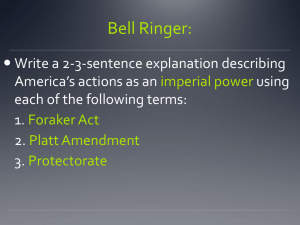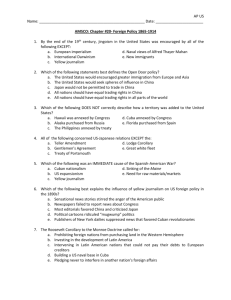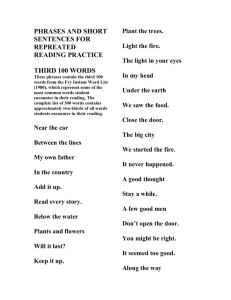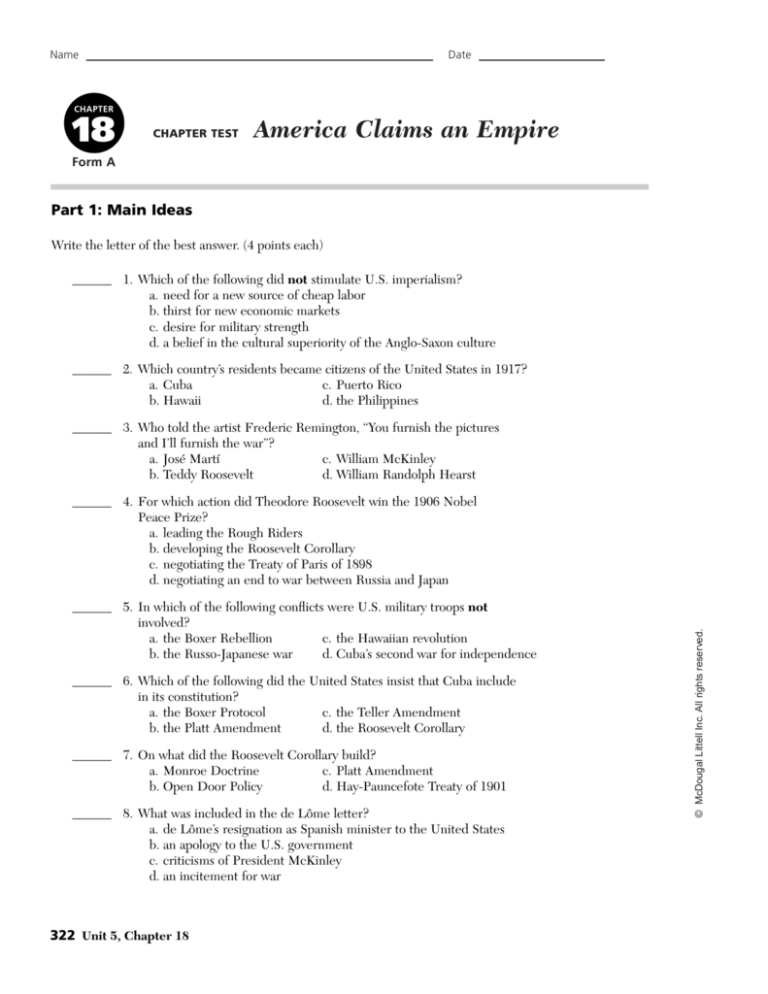
Name
Date
CHAPTER
18
CHAPTER TEST
America Claims an Empire
Form A
Part 1: Main Ideas
Write the letter of the best answer. (4 points each)
______ 1. Which of the following did not stimulate U.S. imperialism?
a. need for a new source of cheap labor
b. thirst for new economic markets
c. desire for military strength
d. a belief in the cultural superiority of the Anglo-Saxon culture
______ 2. Which country’s residents became citizens of the United States in 1917?
a. Cuba
c. Puerto Rico
b. Hawaii
d. the Philippines
______ 3. Who told the artist Frederic Remington, “You furnish the pictures
and I’ll furnish the war”?
a. José Martí
c. William McKinley
b. Teddy Roosevelt
d. William Randolph Hearst
______ 5. In which of the following conflicts were U.S. military troops not
involved?
a. the Boxer Rebellion
c. the Hawaiian revolution
b. the Russo-Japanese war
d. Cuba’s second war for independence
______ 6. Which of the following did the United States insist that Cuba include
in its constitution?
a. the Boxer Protocol
c. the Teller Amendment
b. the Platt Amendment
d. the Roosevelt Corollary
______ 7. On what did the Roosevelt Corollary build?
a. Monroe Doctrine
c. Platt Amendment
b. Open Door Policy
d. Hay-Pauncefote Treaty of 1901
______ 8. What was included in the de Lôme letter?
a. de Lôme’s resignation as Spanish minister to the United States
b. an apology to the U.S. government
c. criticisms of President McKinley
d. an incitement for war
322 Unit 5, Chapter 18
© McDougal Littell Inc. All rights reserved.
______ 4. For which action did Theodore Roosevelt win the 1906 Nobel
Peace Prize?
a. leading the Rough Riders
b. developing the Roosevelt Corollary
c. negotiating the Treaty of Paris of 1898
d. negotiating an end to war between Russia and Japan
Name
Test Form A continued
______ 9. What war ended with the Treaty of Paris of 1898?
a. Spanish-American War
c. Philippine-American War
b. Russo-Japanese War
d. Cuban war for independence
______ 10. What was the purpose of the Foraker Act?
a. to give Cuba and Puerto Rico to the United States
b. to grant Puerto Rican residents U.S. citizenship
c. to end the Puerto Rican uprising
d. to end military rule and set up civil government in Puerto Rico
Part 2: Map Skills
Use the maps to complete this section. Write the letter of the best answer. (4 points each)
The Panama Canal
A Shortcut
Co
ló
n
Canal
Lock
Puerto Pilón
CARIBBEAN
SEA
Road
N
Railroad
Military Base
Buena Vista
GATUN LOCKS
New York City
San
Francisco
UNITED STATES
ATLANTIC
OCEAN
N
PANAMA
Escobal
5,2
00
Gatun
Lake
mi
les
Panama
Canal
000
13,
PEDRO MIGUEL LOCKS
PAC I F I C
OCEAN
MIRAFLORES LOCKS
PANAMA
Panama City
Arraiján
© McDougal Littell Inc. All rights reserved.
0
0
10 Miles
10 Kilometers
Pan
Hig h way
ican
er
Am
SOUTH
AMERICA
es
mil
San Miguelito
Balboa
La Chorrera
PAC I F I C
OCEAN
______ 11. The map on the left shows that a ship traveling through the Panama
Canal from the Caribbean Sea to the Pacific Ocean heads mainly
a. east.
c. southeast.
b. west.
d. southwest.
______ 12. The canal’s length is approximately
a. 10 miles.
c. 100 miles.
b. 50 miles.
d. 1,000 miles.
______ 13. Before entering Gatun Lake from the Caribbean Sea, a ship must
pass through
a. a military base.
c. a bridge.
b. locks.
d. the Pacific Ocean.
America Claims an Empire 323
Name
Test Form A continued
______ 14. Closest to the southern end of the canal lies the city of
a. Colón.
c. Balboa.
b. Panama.
d. Escobal.
______ 15. Before the canal was built, a ship traveling from San Francisco to
New York City would need to travel
a. 5,200 miles.
c. 13,000 miles.
b. 7,800 miles.
d. 18,200 miles.
Part 3: Interpreting Political Cartoons
______ 16. To what does the door in this cartoon open?
a. the United States
c. China
b. a colony
d. Japan
______ 17. Who is waiting outside the door?
a. the Chinese
b. foreigners
324 Unit 5, Chapter 18
c. Americans
d. soldiers
© McDougal Littell Inc. All rights reserved.
Use the cartoon to answer each question. Write the letter of the correct answer.
(4 points each)
Name
Test Form A continued
______ 18. Who holds the key to the door?
a. a French general
b. Teddy Roosevelt
c. a Chinese man
d. Uncle Sam
______ 19. What does the size of the man holding the key indicate?
a. that he is weaker than all of the others outside the door
b. that he is stronger than all of the others outside the door
c. that he is equal in strength to the Chinese
d. that he is equal in strength to the others outside the door
______ 20. What does the cartoon imply about the Open Door Policy?
a. It favored American interests over other foreign interests in China.
b. It treated all foreign interests in China fairly.
c. It weakened American influence in China.
d. It mainly benefited America’s competitors.
Part 4: Extended Response
Answer each of the following questions in a paragraph on the back of this paper or on a
separate sheet. (10 points each)
© McDougal Littell Inc. All rights reserved.
21. What did José Martí, Luis Muñoz Rivera, and Emilio Aquinaldo have in
common? Think About:
• conditions in each man’s country
• the beliefs and actions of each man
• the events in the men’s lives
22. What effect did the yellow journalism used by Hearst and Pulitzer before and
during the Spanish-American War have on American reactions to the situation
in Cuba? Ho do you feel about the use of such journalism? Think About:
• the definition of yellow journalism
• the reasons for using such journalism
• the indirect results of yellow journalism
America Claims an Empire 325


